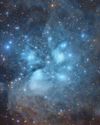Intentar ORO - Gratis
DISTANT TARGET ANALYSIS
All About Space
|Issue 128
When it comes to protecting Earth from impacts, it's crucial to know what asteroids are made of. NASA is working on a device to find out
-

The Solar System is filled with small asteroids and comets, all whizzing around in varying orbits. They represent both a threat to our planet - as demonstrated by the Chelyabinsk meteor in 2013 - and an opportunity for in-space mining. But if we are to deflect or exploit these bodies, we need to know what they are made of, and ideally without having to go to the trouble of landing on them all. Fortunately, Dr Gary Hughes of California Polytechnic State University has a solution to this problem, and he has received funding from NASA to work on it.
We can figure out the compositions of stars over tremendous distances because they are hot bodies emitting light, and we can analyse this light with a technique called spectroscopy. If you let sunlight fall on a prism, you'll see a rainbow split out of the white light, but more careful study will reveal dark lines cutting through the colours at various points. This is because the matter the light is shining through absorbs characteristic wavelengths of light, leading to these gaps - helium was actually found in the Sun this way before it was identified on Earth. But the small objects NASA is interested in interrogating are cold and only reflect light rather than emitting it, so to counter this the agency plans to zap them with a laser.
Esta historia es de la edición Issue 128 de All About Space.
Suscríbete a Magzter GOLD para acceder a miles de historias premium seleccionadas y a más de 9000 revistas y periódicos.
¿Ya eres suscriptor? Iniciar sesión
MÁS HISTORIAS DE All About Space

All About Space UK
MYSTERIES OF THE UNI WHERE ARE ALL THE SPIRAL GALAXIES?
There are far fewer spiral galaxies than elliptical ones in the Supergalactic Plane, and scientists are keen to discover why
7 mins
Issue 161

All About Space UK
ZOMBIE STARS
+10 OTHER TERRIFYING SPACE OBJECTS
8 mins
Issue 161

All About Space UK
HOW TO BEAT LIGHT POLLUTION
Thought it was impossible to observe the wonders of the night sky from towns and cities? Think again. Follow our tips and tricks on successfully observing through sky glow
2 mins
Issue 161

All About Space UK
15 STUNNING STAR CLUSTERS
These beautiful stellar groupings are spattered across the cosmos
8 mins
Issue 161

All About Space UK
Eileen Collins "It was a difficult mission...we were the first to see Mir"
Having served as both the first female pilot and first female commander of NASA's Space Shuttle, Collins boosted the involvement of women in space exploration to a whole new level
9 mins
Issue 161

All About Space UK
MARS LEAKS FASTER WHEN IT'S CLOSER TO THE SUN
The Red Planet has lost enough water to space to form a global ocean hundreds of kilometres deep
2 mins
Issue 161

All About Space UK
FUTURE TECH KANKOH-MARU
This ambitious reusable spacecraft will be capable of taking 50 people to and from orbit
2 mins
Issue 161

All About Space UK
THE FINAL FRONTIER
Beyond the reach of the Sun is a fascinating region of the cosmos that were only just beginning to explore
8 mins
Issue 161

All About Space UK
A long-lost moon could explain Mars' weird shape and extreme terrain
A long-lost moon could explain why Mars is so different from the other rocky planets in the Solar System. Today Mars has two tiny moons.
2 mins
Issue 161

All About Space UK
A sprinkling of cosmic dust may have helped kick-start life on Earth
Cosmic dust may have helped kick-start life on Earth. New findings challenge a widely held assumption that this wasn't a plausible explanation.
3 mins
Issue 161
Translate
Change font size

